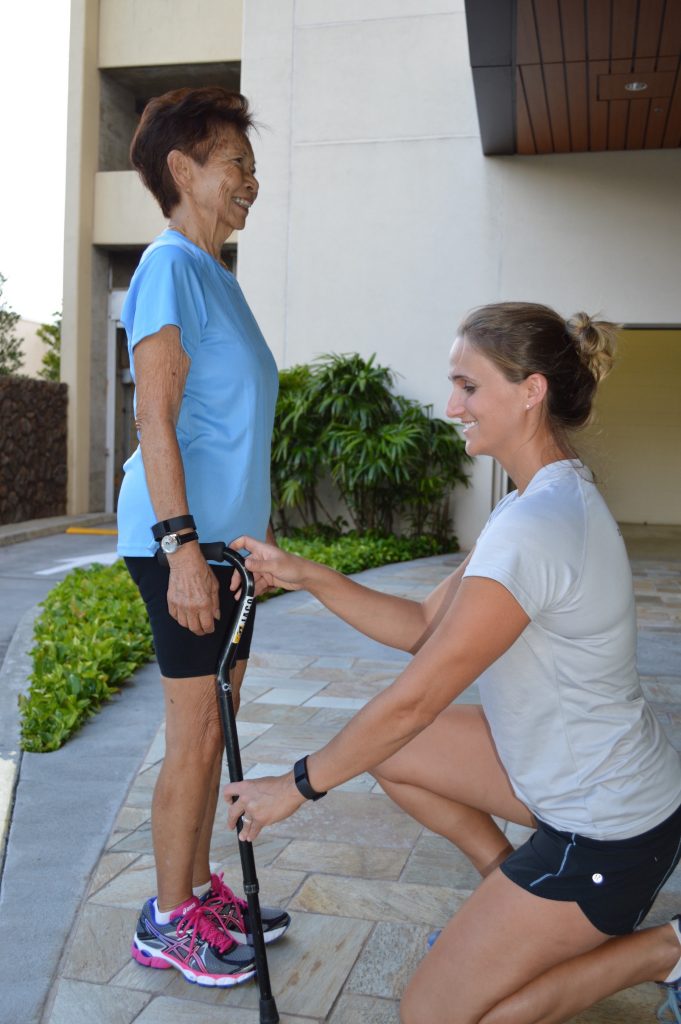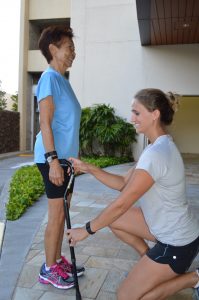
You’re about to have a total knee or hip replacement at a same-day surgical center. Hooray!
Now that your surgery is scheduled, it’s time to prepare. Research shows that prehabilitation (prehab), consisting of carefully prescribed exercises with a physical therapist, is an effective way to ensure positive outcomes after your surgery. (1) That means exercising your hip or knee before surgery can help you get back to your favorite activities quicker.
You should also start preparing for logistical details, including how you’ll get home and who can help you during your first few days home. Many medical facilities have the option to do same-day surgery for total joint replacements as long as you meet certain medical criteria, so you’ll need to organize all those details in advance.
If you’re reading this, it means you’re being proactive about your recovery. We hope the following details help you get ready for the road ahead!
Prehab Addresses Post-Op Details
The goal of a prehab visit is to give you a personalized game-day plan for the few days following your surgery. We set you up for success. This reduces the risk of overdoing it, underdoing it, or doing something that may jeopardize your safety at home and successful healing.
When you attend a prehab session with a physical therapist, you’ll discuss expectations about your recovery. We can point out a few things that are often overlooked when preparing post-op arrangements, including:
- How will you get into your caregiver’s car after your surgery
- How will you get up that step into your home?
- What about stairs in general? Which foot goes first? And what if you don’t have a railing?
- How do you get in and out of your shower or tub? What is the safest way to get in and out of bed? What’s the best resting position for your operative leg?
- What positions should I avoid?
- Are there exercises you should start doing right away to avoid complications? (The answer is yes, by the way)
What about the pain? Many people expect to be in pain, but how do you know if the pain you are experiencing is “normal”? And speaking of normal, what does normal wound healing look like and what are the signs of possible infection or complications you should look out for?
Prehab Teaches You About Your Upcoming Surgery
Learning as much about the surgery as possible can be an advantage. It can aid in your recovery for two reasons:
- You are better psychologically prepared for what to expect.
- It will be easier to understand why certain exercises or precautions are relevant during your recovery.
These two things will be covered in depth at your prehab visit.
In general terms, joint replacement surgery involves removing damaged cartilage and bone, and replacing it with metal and plastic components.
Some of our patients have said watching a YouTube video of their specific total joint replacement surgery was helpful so they could see exactly what was happening inside their body during surgery, and what they were getting prepared to recover from. But this isn’t for everyone! Beware if you have a queasy stomach – orthopedic surgery of any kind is like really technical carpentry work being performed on the human body.
If you’d rather save yourself a graphic YouTube search, read ahead to learn more about the basics. In addition, many doctor’s offices will provide you with educational material specific to the type of surgery you will be having. If they don’t, just ask! They’ll be more than happy to provide you with it.
Total knee replacements and total hip replacements are common in the clinic. At JACO Rehab, we also see many people with shoulder and ankle replacements, although surgeons don’t perform these procedures as often.
Prehab Trains You on a Crutch or Walker
Even if you’ve used crutches before, using them after a total hip or knee replacement may feel different.
In most cases, you will be permitted to put as much weight as you can tolerate through your operative leg after your total joint surgery, which may have not been the case with an injury you’ve had in the past. Depending on the type of past surgery or injury, using crutches when you are completely non-weight-bearing vs. partial weight-bearing is completely different.
A total joint surgery is a big surgery, and you’ll feel really tired. The last thing you’ll want to do is learn how to use an assistive device post-operation. This is why it is important to unwrap your crutches or walker beforehand, fit them to your height, and practice, practice, practice. The more natural your crutch or walker feels beforehand, the less you will have to think about it afterwards.
During your pre-operative prehab visit, your therapist will fit your assistive device to your height, and then teach you how to walk with your crutches, walker, or cane. They will show you different options for walking based on your pain levels and they will show you how to progress from two crutches to one crutch when the time is right. They will also show you how to use your crutches on stairs (up and down), and curbs. You will have the chance to practice these techniques in the clinic with them in simulated environments to ensure you are doing this correctly.
Prehab Teaches You to Follow Precautions
Depending on the type of surgery you have, there may be different precautions (movements or positions you should avoid) that you need to follow for at least six weeks. These rules protect your joint and ensure proper healing after the surgery. Your therapist will discuss these with you in detail at your prehab visit, so you know how to protect healing tissues and avoid complications, like a new joint dislocation.
Not only will your physical therapist discuss any precautions with you, they will review the most common places that people run into challenges when it comes to moving about in their home environment while maintaining their precautions. This may include sitting and standing up from low surfaces such as a toilet, or deep couch. This may also include getting in and out of bed safely.
Don’t Forget to Establish Your “Why”
This is an extremely important step in the process because it motivates you during your healing process. Physical therapists bring up your personal goals during prehab sessions, so start thinking about your “why”.
Generally speaking, there are a few main reasons you may be undergoing a total joint replacement for your knee or hip:
- Most commonly, you have end-stage osteoarthritis in your knee or hip joint. This means the weightbearing cartilage surfaces in your knee or hip are worn away, damaged and inflamed resulting in injury to the bone. Subsequently, you are likely experiencing high levels of pain, stiffness, or discomfort.
- You experienced a traumatic injury such as a fracture in an area that warrants the need for a total joint replacement. Your orthopedic surgeon is the expert in this case and will need to determine whether this is necessary for you or not based on your unique injury.
- The blood supply to your joint has been compromised for another reason, and thus the joint needs to be replaced in order to prevent further damage.
- Less commonly, there may be a tumor in the joint or bone resulting in the need for further stabilization from a joint replacement.
Regardless of the reason, if you are undergoing a total joint replacement, you are likely already limited by pain and stiffness. Your goal of surgery is to improve your quality of life. But what does that look like? What’s the deeper reason? What’s your true “why”?
It could be getting back on your surfboard. Maybe it’s playing with your grandkids with less limitation. These reasons keep you focused and optimistic as you set the framework for your recovery.
How to Prepare for Your Prehab Physical Therapy Appointment
The most important thing you need to do to prepare for your appointment is to observe your home environment beforehand.
Expect your therapist to ask you questions like: Do you have stairs? How many? Is there a railing? What type of shower or tub do you have, and how high is the ledge? Are there grab bars to hold?
Check around your house and see if you have any particular questions about how to move about in your home environment after your surgery. Be thorough.
What to Bring
Make the most out of your prehab appointment! If able, please bring…
- Your assistive device (usually a walker or crutches), which is typically provided to you by your doctor’s office at one of your pre-operative visits.
- Any pre-operative material provided to you by your doctor’s office including exercise sheets, etc. Your therapist can ensure you understand how to properly perform these exercises
- Comfortable, loose-fitting clothes you are able to exercise in. Your therapist will review the most important exercises to perform day 1 to decrease swelling, prevent blood clots, and how to safely start getting your knee moving to prevent stiffness.
- A pen and paper with a list of questions for your therapist.
The prehab visit will prepare you to safely return home the day of your surgery, reduce your risk of injury and set you up for success!
You may have a visit from a home health physical therapist the day following your surgery to answer anything else that comes up. They may show you how to progress your exercises before you begin your outpatient physical therapy sessions.
Reach Out!
We wish you the best of luck with your upcoming surgery, and encourage you to reach out to us with any questions! Please call (808) 381-8947 or E-mail info@jacorehab.com for more information.
Written by Cat Culver, DPT
Sources
1. Widmer P, Oesch P, Bachmann S. Effect of Prehabilitation in Form of Exercise and/or Education in Patients Undergoing Total Hip Arthroplasty on Postoperative Outcomes-A Systematic Review. Medicina (Kaunas). 2022 May 30;58(6):742. doi: 10.3390/medicina58060742. PMID: 35744005; PMCID: PMC9228426.
